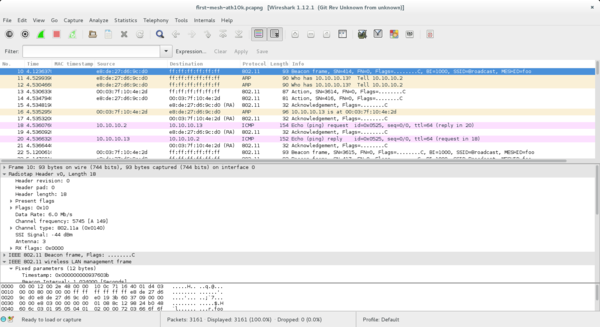I’m a bit late writing this up, as lately wifi stuff has taken a back seat to the day job. But, I’ve now seen the following issue reported more than once, so hopefully this post will save the other two mesh users some grief.
If you are running an encrypted mesh on wpa_supplicant or (ye gods) authsae, take note:
- Encrypted mesh on kernel 4.8 will not interoperate with kernel < 4.8
- wpa_supplicant 2.6 will not interoperate with 2.5
- authsae as of commit 706a2cf will not interoperate with that of commit 813ec0e [1]
- wpa_supplicant 2.6 and authsae commit 706a2cf require additional configuration to work with kernel < 4.8 (see below).
What is behind all of that? A while ago I noticed and mentioned to another networking developer that the 802.11 standard calls for certain group-addressed management frames in mesh networks to be encrypted with the mesh group key (MGTK). However, the implementation in the kernel only integrity-protected these frames, using the integrity group key (IGTK) [2]. I don’t happen to know the history here: it may be that this was something that was changed between the draft and the standard, but anyway that was the state until Masashi Honma fixed it, with patch 46f6b06050b that landed in kernel 4.8.
Meanwhile, Jouni Malinen fixed a bunch of related issues in the wpa_supplicant implementation, namely that IGTK was not being generated properly and instead the MGTK was used for that. I made the same kind of fixes for authsae.
Yes, it’s a multiple(!) flag day and we suck for that.
Now, on to how to fix your mesh.
Old mesh daemon + old kernel everywhere should still work.
Old mesh daemon + new kernel everywhere should still work.
New mesh daemon + new kernel everywhere should still work.
New mesh daemon + pre-4.8 kernel: you will most likely see that peering works but no data goes across because HWMP frames are dropped at the peer. The solution here is to enable PMF in the mesh daemon:
- add “pmf=2” or “ieee80211w=2” to the relevant section of wpa_supplicant.conf
- add “pmf=1;” to the meshd section of authsae.cfg
If you for some reason find yourself in the position of needing to run a mix of old/new wpa_s and/or old/new kernel, here are my (completely untested) suggestions:
- patch the kernel to accept PMF-protected frames as well as encrypted frames (this allows older kernels to work with newer ones)
- patch the new mesh daemon (wpa_supplicant or authsae) to copy the MGTK into the IGTK instead of generating a separate key (this allows older mesh daemon to work with the newer one since older daemon will use MGTK for IGTK).
Both of these will reduce your security and don’t follow the spec, so there’s little chance such changes will go upstream.
[1] Prior to 706a2cf, authsae doesn’t even interoperate with wpa_supplicant due to not filling in all of the elements in peering frames. My advice would be to switch to wpa_supplicant, which has things like a maintainer and a test suite.
[2] On encryption vs integrity protection: the latter is similar to PGP-signing of emails: it makes tampering evident but does not hide the content of the message itself.

